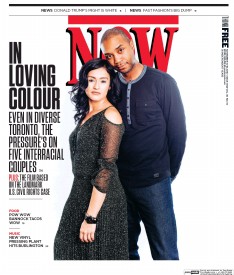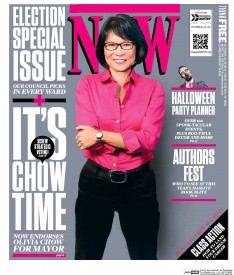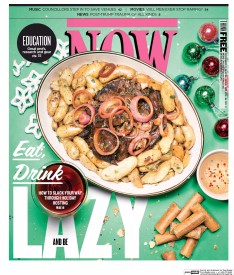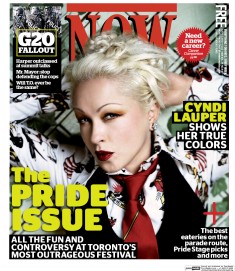
After more than 25 years at Now Magazine creative director Troy Beyer stepped down at the end of October. He designed more than 1,000 covers that graced newsstands and Now’s green newsboxes.
On October 19, Jonathan Goldsbie, staff news writer for Now, sent out a Tweet regarding Beyer’s departure from the magazine. It was the only public acknowledgement of his exit. Beyer had served as the art vice president and creative director for 23 years, clocking in 27 years in total with Now.
“[Now doesn’t] tend to make a big deal of people’s departures,” Goldsbie says. “Not that many places do.”
He notes that there’s a tendency to not broadcast sad news, especially if the person is going to be missed.
He says that if it was someone high-profile leaving, like a columnist, that would be more likely to cause some noise. “All publications could celebrate people behind the scenes… Especially someone like Troy.”
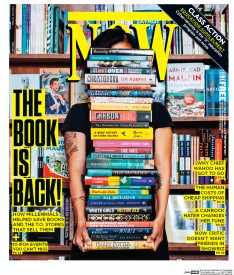
Courtesy: Alice Klein.
The October 20 cover was Beyer’s last design with the magazine.
“After more than 1,300 issues and somewhere in the neighbourhood of 1,000 covers, today was my last day at NOW Magazine. Its very surreal after so many years in the weekly cycle of the Toronto media landscape to be trying something new. I’m proud of what we accomplished together over the years and I’m a bit sad to turn the page on this chapter of my professional life. But I’m looking forward to new challenges with new creative problems and feeling positive about the future. Good luck to my colleagues at NOW! I’ll miss you. Give ’em’ hell.”
~Troy Beyer, Facebook. October 19, 2016.
Beyer designed covers in the 90s about HIV/AIDS, continued working through the 2000s, to Rob Ford’s years at mayor, the shooting of Sammy Yatim, and 2014 World Pride in Toronto. Ultimately, his bread and butter is what Now was known for: entertainment, arts, and music.
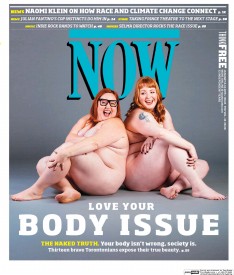
Courtesy: Alice Klein.
“Troy had a really big role in shaping what things we chose to pursue as cover stories,” Goldsbie says. He describes Beyer as a sort of “co-editor in chief,” in regards to how his input shaped the magazine, and he shaped how it was presented.
Several of his covers depict famous actors such as Amanda Plummer, Daniel Radcliffe, and Ellen Page. He’s also published covers featuring artists like Toronto playwright Andrea Scott, Chinese dissident artist Ai Weiwei, and dancer Peggy Baker.
It meant a lot to many people to be on the cover, Goldsbie says. He muses that there’s an appeal to the romantic notion of print, of an old weekly.
“Until I got to Now, I didn’t really appreciate what he did,” Goldsbie says. Despite having a “sometimes controversial aesthetic,” Beyer’s designs had an effect on the city and were part of the “background of the urban landscape of Toronto” whether they were in boxes or on newsstands.
One of Beyer’s favourite covers was 2013’s “The End of Gender.” “It’s a wonderful portrait of two people who are very proudly androgynous,” Goldsbie says.
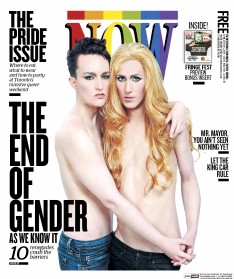
Courtesy: Alice Klein.
As for his least favourite cover, a Hugh Grant photo from March 24, 1994 came to mind. The picture is a “really shitty, really muddy, dark image that… just didn’t look good at all,” Goldsbie says. It wouldn’t have looked much better in the colour it was printed in originally, versus the black and white image shown in Now‘s online archive.
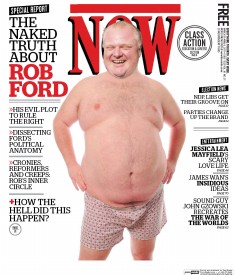
Courtesy: Alice Klein.
The “infamous” March 2011 Rob Ford cover may not be the best, but it turned into a news story of its own, Goldsbie says. A Ford staff member even tried to get city hall to pull the the magazines from City of Toronto’s offices.
According to a comment by Beyer on his Oct. 19 Facebook post, he is now working as a creative director for an unnamed college.
After Beyer’s departure, Michelle Wong stepped into the Art Director position. She’s worked for Now for six and a half years, formerly as the magazine’s graphic and web designer.
Her design choices vary from Beyer’s. Beyer used an incredible amount of text and teased as many stories as he could. He didn’t like white space. Wong, on the other hand, has “much more tolerance for white space.” Her covers have “a cleaner look,” according to Goldsbie.”Aesthetically they have different opinions on [blank space],” Goldsbie says.”I doubt anyone will really notice unless they’re specifically looking for it.”
While it sounds like Beyer will be missed by his colleagues, Wong will keep the magazine looking clean and fresh. By utilizing Now’s openness to experimentation, she is sure to continue the success of one of Toronto’s last weeklies while putting her own mark on the city’s landscape.
